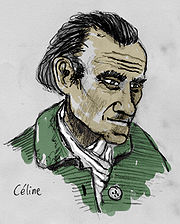Louis-Ferdinand C‚line's Human Design Chart
1/3 Emotional Manifesting GeneratorFrench novelist, polemicist and physician, whose first novel Journey to the End of the Night (1932) won the Prix Renaudot but divided critics due to the author’s pessimistic depiction of the human condition and his writing style based on working class speech. In subsequent novels such as Death on the Installment Plan (1936), Guignol’s Band (1944) and Castle to Castle (1957) C‚line further developed an innovative and distinctive literary style.
He completed his medical studies at Rennes in 1924 and began working as a physician in Africa and America for the Rockefeller Foundation and League of Nations before setting up a practice in Paris.
The son of an insurance salesman, Louis spent his youth in Paris, where his mother set up a lace shop in the passage Choiseul. Eager to see their son in business, his parents sent him abroad to learn languages. In 1912, at the age of 18, he enlisted in a cavalry unit, the 12th Regiment of the Cuirassiers. He was seriously wounded during World War I in Ypres, which left him with a permanently damaged arm and severe headaches that lasted all his life. He was awarded the M‚daille militaire and a disability pension. He was then assigned to the French passport office in London. In 1916 he worked for a lumber company in Cameroun and was sent back to France with malaria and dysentery. C‚line studied medicine in Rennes and received his degree from the University of Paris in 1924.
In 1915 he married Suzanne Nebout, a Frenchwoman working as a barmaid in London, but this marriage was not registered with the French consulate. In 1919 he married Edith Follet, whose father was the director of a medical school. In the following year, 1925, he left his practice, his wife, and his child to work for the League of Nations. His second marriage ended in 1926.
Employed by the League of Nations, C‚line traveled in Switzerland, Cameroon, the United States, Cuba, and Canada. In Detroit he studied the working conditions in the Ford factory. In 1928 he opened a private practice in a suburb of Paris and in 1931 he began to work for a municipal clinic at Clichy, in Paris.
Using the pseudonym “Celine” he published his controversial, prize-winning first novel, Journey to the End of the Night in 1934. His second novel, Death on the Installment Plan received immediate acclaim. Anti-Semitic, he wrote with bitterness and corrosive humor. Although C‚line?s political ideals had much in common with the Nazis, he claimed that Hitler was a Jew. C‚line’s writings also expressed the fears of an anti-Semitic petit bourgeois who bitterly resented L‚on Blum’s Popular Front government (1936-1938).
At the outbreak of World War II he served as a volunteer doctor on a French naval vessel, which was sunk by a Nazi submarine. After the fall of France in 1940, he rejected both resistance and collaboration and worked in municipal clinics in Satrouville and in a Bezons dispensary. He was denounced on the BBC as a traitor and to avoid execution by the resistance during the allied liberation of France, he fled to Berlin in 1944 with his third wife, the dancer Lucette Almanzor, whom he married in 1943. In Germany he was arrested for a short time. He finally settled in Denmark in 1945, where he was interned for over a year because of accusations of the Resistance. Released on the ground of ill health, he was permitted to return to France, spending his last years as a recluse and doctor for the poor.
Celine died on 1 July 1961 in Meudon, France.
Link to Wikipedia biography
Discover More Famous People
Browse and analyze over 55,000 public figures and celebrities.
Ra Uru Hu
5/1 Manifestor
Martha Stewart
4/6 Manifestor
David Lynch
4/6 Generator
Barack Obama
6/2 Projector
Steve Jobs
6/3 Generator
Vladimir Putin
5/1 Manifestor
Kim Kardashian
3/5 Generator
Michael Jackson
1/3 Projector
Marilyn Monroe
6/2 Projector
Ariana Grande
2/4 Projector
Oprah Winfrey
2/4 Generator
Johnny Depp
2/4 ManifestorWhat is HumanDesign.ai and how does it work?
Curious what makes Louis-Ferdinand C‚line tick? HumanDesign.ai instantly maps their exact birth data into a fully interactive clickable bodygraph chart, letting you hover or tap every center, channel, and gate for plain-language explanations. Bella, the platform’s built-in AI guide, adds context in real time, translating complex mechanics into everyday insights so you can see how Louis-Ferdinand C‚line’s strengths, challenges, and life themes play out on-screen.
The same tools are waiting for you. Generate your own Human Design Chart in seconds, open a library of 2000+ suggested questions, and chat with Bella as often as you like to decode your design, daily transits, and even relationship dynamics.
Want to compare energies? Save unlimited charts for friends, family, or clients, then ask Bella to reveal compatibilities, composite patterns, or coaching tips, all in one conversation thread.
Start free with core features, or unlock our Personal and Pro plans for deeper dives: unlimited Q&A, celebrity chart search spanning 55,000+ public figures, white-label PDF reports, branded content generation, and a professional profile with built-in booking for practitioners. Whether you’re exploring your own potential or guiding others, HumanDesign.ai delivers an ever-expanding toolbox of AI-powered insights—no spreadsheets, no jargon, just clarity at your fingertips.
Ready to see yours? Signup for FREE today!

